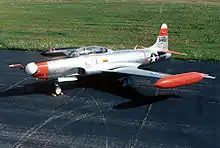Capital Airlines Flight 300
On May 20, 1958 a Vickers Viscount airliner operating Capital Airlines Flight 300 was involved in a mid air collision with a USAF T-33 jet trainer on a proficiency flight in the skies above Brunswick, Maryland. All 11 people on board the Viscount and one of the two crew in the T-33 were killed in the accident. Flight 300 was the second of four fatal crashes in the space of two years involving Capital Airlines Vickers Viscounts; the other were Capital Airlines Flight 67 (April 1958) Capital Airlines Flight 75 (May 1959) and Capital Airlines Flight 20 (January 1960).
.jpg.webp) Forward section of the Vickers Viscount | |
| Accident | |
|---|---|
| Date | May 20, 1958 |
| Summary | Mid-air collision |
| Site | Four miles east-northeast of Brunswick, Maryland 39°19′50″N 77°32′39″W |
| Total fatalities | 12 |
| Total injuries | 1 |
| Total survivors | 1 |
| First aircraft | |
 A Vickers Viscount similar to the one involved in the incident. | |
| Type | Vickers Viscount |
| Operator | Capital Airlines |
| Registration | N7410 |
| Passengers | 7 |
| Crew | 4 |
| Survivors | 0 |
| Second aircraft | |
 A T-33 Shooting Star similar to the one involved in the incident. | |
| Type | Lockheed T-33 |
| Operator | USAF Maryland Air National Guard |
| Registration | 53-5966 |
| Crew | 2 |
| Survivors | 1 |
An investigation of the accident concluded that the pilot in command of the T-33 failed to see and maintain a safe distance from other air traffic.
Accident
Capital Airlines Flight 300 was a regular scheduled flight from Chicago, Illinois to Baltimore, Maryland with an intermediate stop at Pittsburgh, Pennsylvania. The flight from Chicago was uneventful and at 10:50 local time the airliner departed Pittsburgh bound for Baltimore. At 11:25 while cruising at 11,000 feet Washington Air Traffic Control cleared Flight 300 to descend and maintain 7,000 feet. At 11:26 the Viscount crew reported descending through 10,000 feet over Martinsburg and radar contact was made by ATC. 48 seconds later flight 300 reported leaving 9,000 feet with clearance to 5,000 feet. This was the last radio transmission from the Viscount.[1]
The T-33 jet trainer launched from Martin State Airport at 11:07 for a VFR familiarization flight. The T-33's air speed was significantly higher as it approached the Viscount from the left and behind. The Viscounts indicated air speed was 235 knots while the T-33's was 290 knots with a closing rate of approximately 195 knots. While slowly climbing through 8,000 feet at 85 percent engine power the jet banked slightly to the right and impacted the left side of the airliner forward of the wing. The airliner pitched up, its air speed decreasing, then the nose dropped and the aircraft entered a steep spin to the right, slowing to a flat spin before it struck the ground. The T-33 pilot was thrown clear of the flaming jet and parachuted safely to the ground but was badly burned. The jet disintegrated after the collision and the passenger was fatally injured.[1][2][3]
Aircraft and crew
Vickers aircraft and crew
The four engine Viscount V.745 British medium-range turboprop airliner, serial number 108, first flew from Hampshire, England on 6 January, 1956. Powered by Rolls-Royce Dart RDa3 Mark 506 engines turning four blade square tipped constant-speed propellers, it was delivered to Capital Airlines on 15 January, 1956 as fleet number 329.[1]
The pilot in command of Flight 300 was Captain Kendall Brady, age 38. He had a valid airman certificate and was rated to fly single/multi-engine land aircraft as well as the Douglas DC-3, DC-4 and the Vickers Viscount. Brady's total flying hours were 12,719 with 1,432 of those in the Viscount. He was hired by Capital Airlines on 11 June, 1945.[1]
Paul Meyer, age 26, served as co-pilot and started flying for Capital Airlines on 25 May, 1956. He was certified to operate single/multi-engine land aircraft and had an instrument rating. Meyer's total flight hours were 2,467, of which 1,596 were in the Viscount.[1]
T-33 aircraft and crew
The two-place Lockheed T-33A Shooting Star subsonic American jet trainer aircraft involved was manufacture serial number 580-9528 and registered 53-5966. It was maintained by the Maryland Air National Guard and equipped with an Allison J33-A-35 turbojet engine.[1]
The pilot and sole survivor of the accident was Captain Julius McCoy, age 34. He was rated as a military pilot August 4, 1944 and joined the Maryland Air National Guard in 1952. He had a total of 1,902 hours in single- and multi-engine and single-engine jet aircraft 210 were in the T-33.[1]
Investigation
The Civil Aeronautics Board (CAB) investigated the accident and released a report on January 9, 1959. It determined that the collision happened during VFR conditions and that both aircraft would have been in clear cloud free air nine-tenths of the time. The report noted that it is the overtaking aircraft's responsibility to see and avoid a collision. A contributing factor in the accident was that the small size of the T-33 made it difficult to pick up on radar. The board attributed no blame to the Viscount crew and stated in conclusion that "The Board determines the probable cause of this accident was the failure of the T-33 pilot to exercise a proper and adequate vigilance to see and avoid other traffic."[1]
See also
- Eastern Air Lines Flight 45
- 1958 in aviation
- List of accidents and incidents on commercial aircraft
- Mid-air collision - includes a list of other notable mid-air collisions.
References
- "Aircraft Accident Report" (PDF). www.baesel.net. CIVIL AERONAUTICS BOARD. January 9, 1959. Retrieved 16 April 2018.
- "Accident description". aviation-safety.net. Aviation Safety Network (ASN). 2018. Retrieved 16 April 2018.
- Geoff Blampied (2018). "Viscount c/n 108". www.vickersviscount.net. Vickers Viscount Network. Retrieved 16 April 2018.